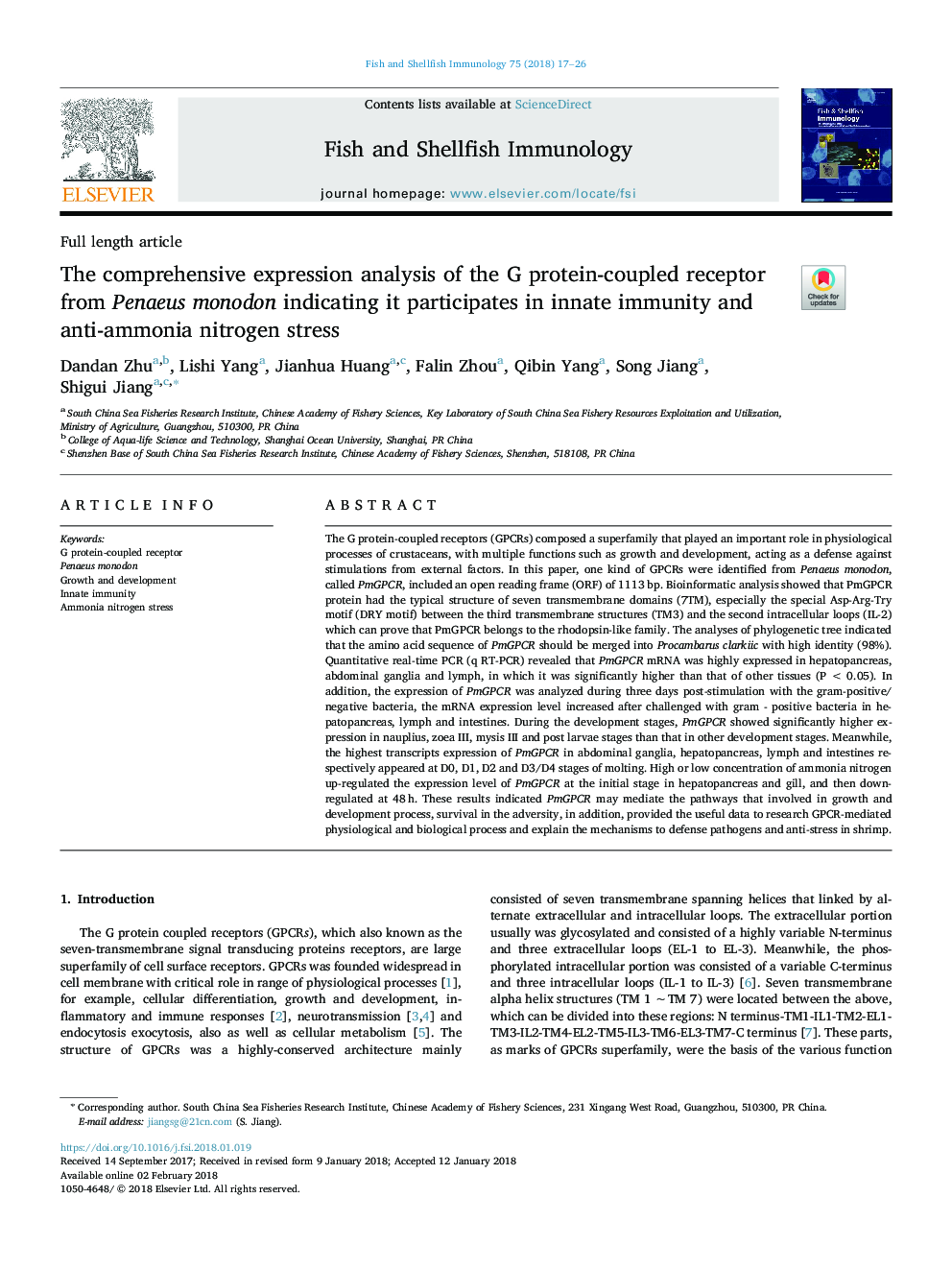| کد مقاله | کد نشریه | سال انتشار | مقاله انگلیسی | نسخه تمام متن |
|---|---|---|---|---|
| 8498528 | 1553599 | 2018 | 10 صفحه PDF | دانلود رایگان |
عنوان انگلیسی مقاله ISI
The comprehensive expression analysis of the G protein-coupled receptor from Penaeus monodon indicating it participates in innate immunity and anti-ammonia nitrogen stress
دانلود مقاله + سفارش ترجمه
دانلود مقاله ISI انگلیسی
رایگان برای ایرانیان
کلمات کلیدی
موضوعات مرتبط
علوم زیستی و بیوفناوری
علوم کشاورزی و بیولوژیک
علوم آبزیان
پیش نمایش صفحه اول مقاله

چکیده انگلیسی
The G protein-coupled receptors (GPCRs) composed a superfamily that played an important role in physiological processes of crustaceans, with multiple functions such as growth and development, acting as a defense against stimulations from external factors. In this paper, one kind of GPCRs were identified from Penaeus monodon, called PmGPCR, included an open reading frame (ORF) of 1113 bp. Bioinformatic analysis showed that PmGPCR protein had the typical structure of seven transmembrane domains (7TM), especially the special Asp-Arg-Try motif (DRY motif) between the third transmembrane structures (TM3) and the second intracellular loops (IL-2) which can prove that PmGPCR belongs to the rhodopsin-like family. The analyses of phylogenetic tree indicated that the amino acid sequence of PmGPCR should be merged into Procambarus clarkiic with high identity (98%). Quantitative real-time PCR (q RT-PCR) revealed that PmGPCR mRNA was highly expressed in hepatopancreas, abdominal ganglia and lymph, in which it was significantly higher than that of other tissues (Pâ¯<â¯0.05). In addition, the expression of PmGPCR was analyzed during three days post-stimulation with the gram-positive/negative bacteria, the mRNA expression level increased after challenged with gram - positive bacteria in hepatopancreas, lymph and intestines. During the development stages, PmGPCR showed significantly higher expression in nauplius, zoea III, mysis III and post larvae stages than that in other development stages. Meanwhile, the highest transcripts expression of PmGPCR in abdominal ganglia, hepatopancreas, lymph and intestines respectively appeared at D0, D1, D2 and D3/D4 stages of molting. High or low concentration of ammonia nitrogen up-regulated the expression level of PmGPCR at the initial stage in hepatopancreas and gill, and then down-regulated at 48â¯h. These results indicated PmGPCR may mediate the pathways that involved in growth and development process, survival in the adversity, in addition, provided the useful data to research GPCR-mediated physiological and biological process and explain the mechanisms to defense pathogens and anti-stress in shrimp.
ناشر
Database: Elsevier - ScienceDirect (ساینس دایرکت)
Journal: Fish & Shellfish Immunology - Volume 75, April 2018, Pages 17-26
Journal: Fish & Shellfish Immunology - Volume 75, April 2018, Pages 17-26
نویسندگان
Dandan Zhu, Lishi Yang, Jianhua Huang, Falin Zhou, Qibin Yang, Song Jiang, Shigui Jiang,